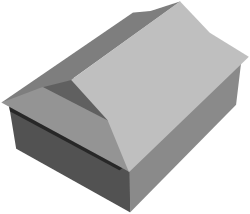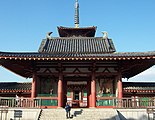Irimoya
A xieshan style or irimoya (入母屋) roof in Japanese architecture is a hip roof (sloping down on all four sides) integrated on two opposing sides with a gable.[1] It can be also described in English as a hip-and-gable, gablet, or (more ambiguously) Dutch gable roof. When however the angle of the hip-and-gable roof is greater at the gable, the roof is said to be a shikoro-buki (錣葺) or shikoro-yane (錣屋根) (see gallery).
Originally used only at Buddhist temples or shrines, its gable is usually right above the moya, or core, while the hip covers the hisashi, a veranda-like aisle surrounding the core on one or more sides. [1]
The style is of Chinese origin and arrived in Japan together with Buddhism in the 6th century. Normally called Irimoya-zukuri (入母屋造 lit. hip and gable roof style), it was originally used in the kon-dō and kō-dō (lecture hall) of Buddhist temples, but started to be used also for the honden at shrines later, during the Japanese Middle Ages.[2] It is still in wide use, especially in Buddhist temples and Shinto shrines, but also in palaces, castles, and folk dwellings. In the last case, it is often called moya-zukuri (母屋造).[1]
[edit] Gallery
-
Yakushi-ji's (Dai)kō-dō
-
An irimoya roof at Shimogamo Shrine
-
Shitennō-ji main gate and its shikoro-yane
-
This portable shrine has a shikoro-yane
[edit] References
- ^ a b c "Irimoya-zukuri". JAANUS: Japanese Architecture and Art Net Users System. http://www.aisf.or.jp/~jaanus/deta/i/irimoyazukuri.htm. Retrieved 2009-05-31.
- ^ Iwanami Nihonshi Jiten (岩波日本史辞典), CD-Rom Version. Iwanami Shoten, 1999-2001.
|
|||||||||||||||||||||||||||||||||||||
|
||||||||||||||||||||||||||||||||||||||||||||||||||||||||
|
||||||||||||||||||||||||||||||||||||||||||
| This architectural element-related article is a stub. You can help Wikipedia by expanding it. |







